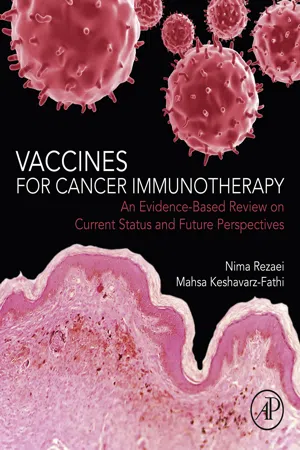
Vaccines for Cancer Immunotherapy
An Evidence-Based Review on Current Status and Future Perspectives
Nima Rezaei,Mahsa Keshavarz-Fathi
- 198 Seiten
- English
- ePUB (handyfreundlich)
- Über iOS und Android verfügbar
Vaccines for Cancer Immunotherapy
An Evidence-Based Review on Current Status and Future Perspectives
Nima Rezaei,Mahsa Keshavarz-Fathi
Über dieses Buch
Therapeutic cancer vaccines represent a type of active cancer immunotherapy. Clinicians, scientists, and researchers working on cancer treatment require evidence-based and up-to-date resources relating to therapeutic cancer vaccines. Vaccines for Cancer Immunotherapy provides a reference for cancer treatment for clinicians and presents a well-organized resource for determining high-potential research areas. The book considers that this promising modality can be made more feasible as a treatment for cancer. Chapters cover cancer immunology, general approaches to cancer immunotherapy, vaccines, tumor antigens, the strategy of allogeneic and autologous cancer vaccines, personalized vaccines, whole-tumor antigen vaccines, protein and peptide vaccines, dendritic cell vaccines, genetic vaccines, candidate cancers for vaccination, obstacles to developing therapeutic cancer vaccines, combination therapy, future perspectives and concluding remarks on therapeutic cancer vaccines.
- Introduces the feasible immunotherapeutic vaccines for patients with different types of cancer
- Presents the status of past and current vaccines for cancer treatment
- Considers advantages and disadvantages of different therapeutic cancer vaccines
- Looks at the combination of vaccines and other modalities, including immunotherapeutic and conventional methods
- Analyzes obstacles to development of therapeutic cancer vaccines
- Gives a view on future perspectives in the application of therapeutic cancer vaccines
Häufig gestellte Fragen
Information
Cancer Immunology
Abstract
Keywords
Innate and Adoptive Immunity
Activating Immune Cells
Inhaltsverzeichnis
- Cover image
- Title page
- Table of Contents
- Copyright
- List of Contributors
- Preface
- Chapter 1. Cancer Immunology
- Chapter 2. Immunotherapeutic Approaches in Cancer
- Chapter 3. Vaccines, Adjuvants, and Delivery Systems
- Chapter 4. Tumor Antigens
- Chapter 5. Strategy of Allogeneic and Autologous Cancer Vaccines
- Chapter 6. Personalized Cancer Vaccine
- Chapter 7. Whole Tumor Cell Vaccine for Cancer
- Chapter 8. Peptide and Protein Vaccines for Cancer
- Chapter 9. Immune Cell Vaccine for Cancer
- Chapter 10. Genetic Vaccine for Cancer
- Chapter 11. Candidate Cancers for Vaccination
- Chapter 12. Obstacles in the Development of Therapeutic Cancer Vaccines
- Chapter 13. Combination Therapy: Cancer Vaccines and Other Therapeutics
- Chapter 14. Concluding Remarks and Future Perspectives on Therapeutic Cancer Vaccines
- Index